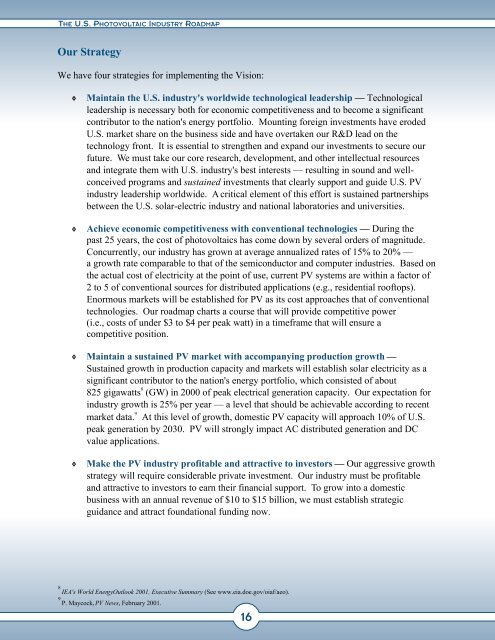Solar Electric Power -- The U.S. Photovoltaic Industry ... - Ecotopia
Solar Electric Power -- The U.S. Photovoltaic Industry ... - Ecotopia
Solar Electric Power -- The U.S. Photovoltaic Industry ... - Ecotopia
You also want an ePaper? Increase the reach of your titles
YUMPU automatically turns print PDFs into web optimized ePapers that Google loves.
THE U.S. PHOTOVOLTAIC INDUSTRY ROADMAP<br />
Our Strategy<br />
We have four strategies for implementing the Vision:<br />
� Maintain the U.S. industry's worldwide technological leadership — Technological<br />
leadership is necessary both for economic competitiveness and to become a significant<br />
contributor to the nation's energy portfolio. Mounting foreign investments have eroded<br />
U.S. market share on the business side and have overtaken our R&D lead on the<br />
technology front. It is essential to strengthen and expand our investments to secure our<br />
future. We must take our core research, development, and other intellectual resources<br />
and integrate them with U.S. industry's best interests — resulting in sound and wellconceived<br />
programs and sustained investments that clearly support and guide U.S. PV<br />
industry leadership worldwide. A critical element of this effort is sustained partnerships<br />
between the U.S. solar-electric industry and national laboratories and universities.<br />
� Achieve economic competitiveness with conventional technologies — During the<br />
past 25 years, the cost of photovoltaics has come down by several orders of magnitude.<br />
Concurrently, our industry has grown at average annualized rates of 15% to 20% —<br />
a growth rate comparable to that of the semiconductor and computer industries. Based on<br />
the actual cost of electricity at the point of use, current PV systems are within a factor of<br />
2 to 5 of conventional sources for distributed applications (e.g., residential rooftops).<br />
Enormous markets will be established for PV as its cost approaches that of conventional<br />
technologies. Our roadmap charts a course that will provide competitive power<br />
(i.e., costs of under $3 to $4 per peak watt) in a timeframe that will ensure a<br />
competitive position.<br />
� Maintain a sustained PV market with accompanying production growth —<br />
Sustained growth in production capacity and markets will establish solar electricity as a<br />
significant contributor to the nation's energy portfolio, which consisted of about<br />
8<br />
825 gigawatts (GW) in 2000 of peak electrical generation capacity. Our expectation for<br />
industry growth is 25% per year — a level that should be achievable according to recent<br />
9<br />
market data. At this level of growth, domestic PV capacity will approach 10% of U.S.<br />
peak generation by 2030. PV will strongly impact AC distributed generation and DC<br />
value applications.<br />
� Make the PV industry profitable and attractive to investors — Our aggressive growth<br />
strategy will require considerable private investment. Our industry must be profitable<br />
and attractive to investors to earn their financial support. To grow into a domestic<br />
business with an annual revenue of $10 to $15 billion, we must establish strategic<br />
guidance and attract foundational funding now.<br />
8<br />
IEA's World EnergyOutlook 2001, Executive Summary (See www.eia.doe.gov/oiaf/aeo).<br />
9<br />
P. Maycock, PV News, February 2001.<br />
16


